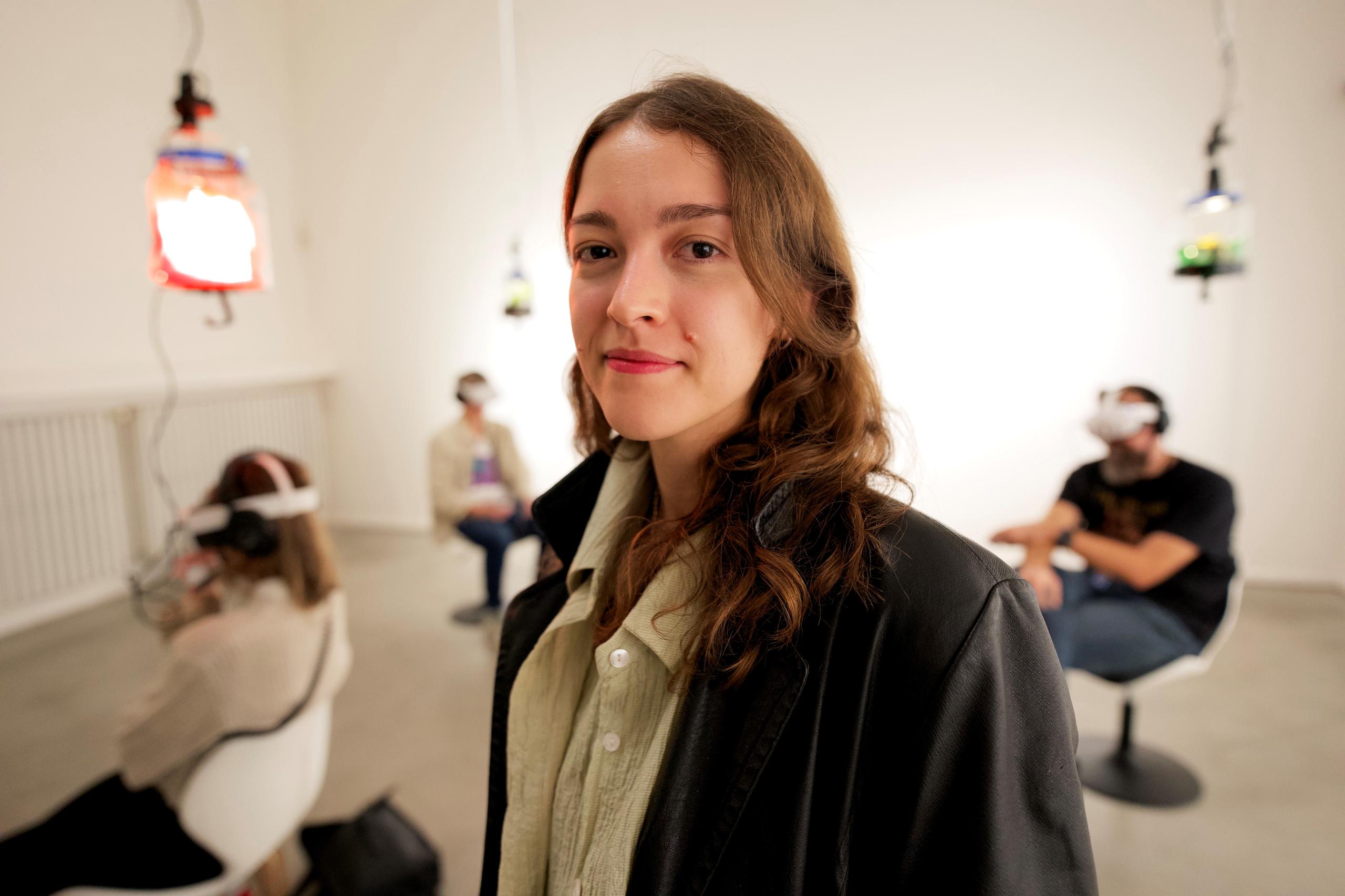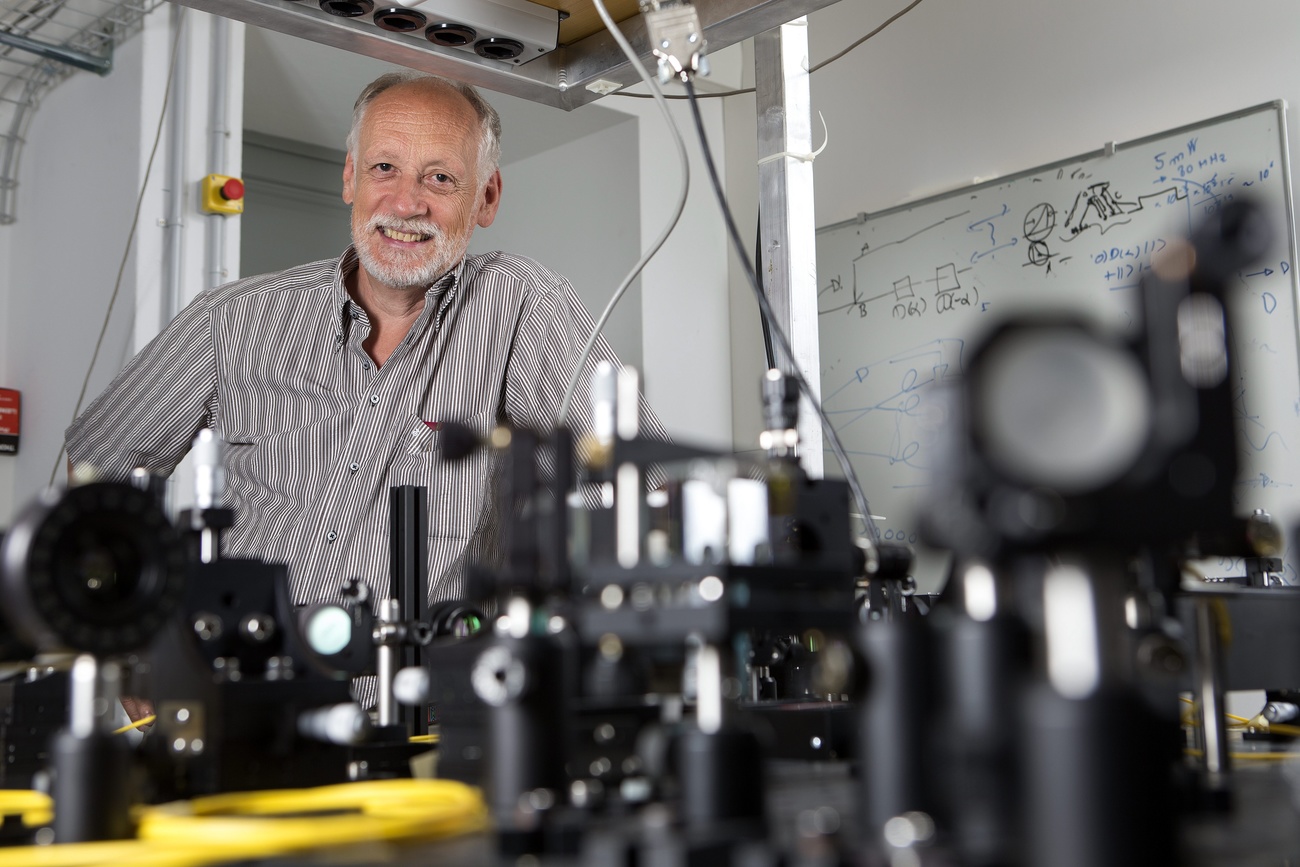Libby Heaney’s quantum soup served in Basel

Quantum Soup is the first solo exhibition of visual artist and quantum physicist Libby Heaney in Switzerland. On display in Basel, her pioneering work makes us look at the world through the lens of the counterintuitive rules of the infinitely small.
People’s understanding of the world owes a lot to the laws of Isaac Newton and the principle of cause and effect. If something is going up, it cannot possibly be going down at the same time. Those who believe such reasoning can explain the infinitely small world of electrons, protons, photons, and bosons, however, are bound to feel a lot of disappointment. And no small amount of frustration.
This is not the case for Libby HeaneyExternal link. When we meet her at the House of Electronic Art (HEK) in Basel, she explains one of the concepts behind her art, the principle of quantum superposition, according to which an entity, like an atom or a particle, can exist in more than one contradictory state at the same time.

“If I were a quantum particle, I could be here and in London at the same time,” she says. “Another analogy might be a coin spinning in the air and not stopping. It is heads and tails at once.” At least until it lands. With measurement, the superposition collapses.
Ironically, this young British woman is both a scientist and an artist, two different but inseparable aspects that emerge distinctly when discussing her exhibition and her worldview.
SWI swissinfo.ch: What is the place of quantum physics in your art?
Libby Haeney: I use quantum physics as a prism through which to see reality in a non-binary, queer way, and to see reality as deeply interconnected (with itself and alternative realities). Why is that important? Because we live in very polarised and individualistic times: trying to make money, left versus right, us versus them. I’m trying to show that we can see things differently.
SWI: You were the first artist to use a quantum computer as an artistic medium. How?
L.H: Obviously, I do not own a quantum computer. I think they cost £100 million (CHF114 million). Or francs, sorry, we’re in Switzerland!
IBM has quantum computers that are publicly available, and anyone can sign up for an account. Because I have a PhD in quantum information science, I understand how to program certain things.

More
Quantum physics: the ‘laws of the absurd’, explained
On the quantum computer I created a phenomenon called quantum entanglement. You can think [of the result] as an object in a highly multidimensional space. It’s almost like I’m creating a multiverse inside a quantum computer, where different realities all exist at once.
I program it in such a way that I can start to see the patterns, the wavelike motion of this multiverse, this big, entangled object. And then I use the data to edit videos. So, 32 videos all exist at the same time in a sort of giant superposition.
A short extract of the video installation slimeQrawl, that Heaney created working with IBM’s 5-qubit quantum computer:
SWI: Is there one of your works you feel particularly attached to?
L.H: When I was making the virtual reality work Heartbreak and Magic, I worked with a team of developers. I do some of the developing, but it’s a lot of work. Many people participate in creating a work of art. When we added all the different magical quantum effects into the world we created, I went inside with virtual reality goggles, and I knew that my work had taken on a life of its own. It had become a quantum universe. It had become greater than my intention, or the developers’ intention.
It became magical. I cry when I see the work. It’s beautiful and emotional. And sad. I think it captures what it means to be alive, the sheer beauty and sheer sadness of life and death.

SWI: Heartbreak and magic is dedicated to your sister, who died of suicide in 2019. Can we say that quantum physics helped you process the loss?
L.H: I didn’t choose to turn to quantum physics. As anyone who’s ever experienced a sudden loss knows, grief transports you into a different reality. You feel detached from people and normal life. The world carries on and you and your family are in a bubble.
When someone you love dies suddenly, your brain can’t quite comprehend it. I can’t speak for other people, but I had to find some way to make sense of it. And I guess this is what humans have done throughout history with religion. I’m not religious and the only thing I knew that was bigger than me that could have some answers was quantum physics.
When I gave a speech at my sister’s funeral it was January, in the middle of England, near Birmingham. Cold, dark and grey. As I finished my speech, a butterfly flew around the top of the church. It wasn’t a moth; it was a butterfly: red and colourful. Everyone saw it. It wasn’t just me. It wasn’t some hallucination. And my sister had a butterfly tattoo on her foot. Of course, it can be a coincidence. But when do you ever see a butterfly in January, in England? You don’t.
It could be random, but to me, it feels there’s something more. Could she still exist somewhere in the multiverse? In quantum science, you can’t delete a known information. Where does the DNA information, the information from us, go? Do we become this delocalised form?

SWI: You use quantum computers to highlight risks and opportunities of this technology. What are they?
L.H: On one hand, big tech companies are using tools like AI and the internet to collect a lot of data about us. At least in the UK, elections have been manipulated. The Brexit vote was manipulated through online interference. When we’re on social media, we don’t really understand to what extent machine learning is making predictions about what we want to buy. I feel that quantum computing will exponentially accelerate surveillance capitalism.
On the other hand, future quantum computers will be very good at modelling reality – microscopic systems, biological systems – more precisely than could ever be possible on digital computers. We might be able to understand photosynthesis, and then mimic it. There are some positive aspects but there’s also a lot of negative aspects.
My work Q is climate (?) explores this. Scientists and tech companies are saying: “Yeah, we can make a new generation of lithium-ion batteries”. But they still aren’t considering the waste, still aren’t considering the land destroyed for the extraction and how it disrupts people in the Global South. What I’m trying to propose with my work is an alternative to the cycle of positive and negative, a different future, which benefits everyone. Because instead of thinking in terms of binaries, we can think in terms of pluralities. And understand that we’re deeply entangled.

SWI: Is your art a way to achieve this?
L.H: I am also a scientist, and in my experience, scientists are so pleased with the tools they’ve made, they don’t stop to think about how they’re going to impact the world. I don’t want to instrumentalise art, but I think art is a good space for storytelling and for new imaginaries. Not a space in which to be lectured about quantum physics, I don’t need to do that.
However, I would encourage anyone to explore. Quantum is difficult, but it’s so magical. Machine learning and AI are the present. But the future will be quantum.
Edited Virginie Mangin, Eduardo Simantob/ds

In compliance with the JTI standards
More: SWI swissinfo.ch certified by the Journalism Trust Initiative











You can find an overview of ongoing debates with our journalists here . Please join us!
If you want to start a conversation about a topic raised in this article or want to report factual errors, email us at english@swissinfo.ch.